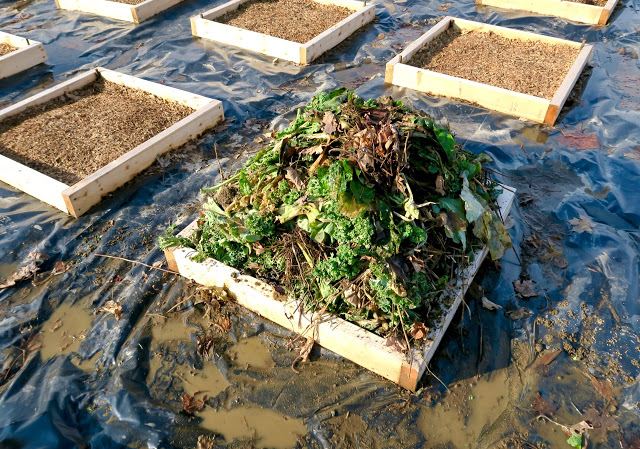I just saw this last night over at Upland:
“After pulling up those tillage radishes, and seeing several other plants in the garden that could be pulled and tossed into my compost pile, it occurred to me that I should try composting some of the garden waste in a minibed. This isn’t an original idea with me. I saw it mentioned recently in a YouTube video by my gardening friend, David The Good.
David and his family are living (and gardening) among the natives in a mysterious undisclosed Caribbean location. You can subscribe to David’s YouTube Channel and follow the adventure. Every so often, you’ll see him sporting a Planet Whizbang hat in his videos. That always puts a smile on my face.
It seems like a good and logical idea to pile garden waste in a minibed and let it compost down. But I’m pretty sure I read somewhere that a compost pile will not “work” unless it is at least a 36″ square cube in size. The minibeds are only 30″ square, and the bed frame is only 3-1/2″ high. That’s hardly big enough.
But I don’t call it a Minibeds-on-Plastic experimental garden for nothing.
I rounded up a variety of old and mostly mushy vegetation from my garden and made a pile in Minibed E7 (please refer now to your copy of The Report to locate minibed E7). Into the pile I put the tillage radishes, along with beet tops, kale tops, carrot tops, chard tops, broccoli tops, buckwheat straw (from a cover crop I planted last year), and some odd tree leaves.
I cut up some of the bigger pieces of vegetation with a knife before adding it to the pile. Here’s a picture…
That’s quite a pile, but it will settle down considerably in time. It is best to cover a compost pile in order to maintain a steady moisture level, so I put a piece of 1mil black plastic over the top…
One tire sidewall on top, four on the sides, and the plastic will stay in place. I’ll push my compost thermometer into the pile in the spring and see if it has any heat to it. It might not, and if not, I think I will redistribute the contents into bed E6, while mixing in some high-nitrogen feathermeal.
The feathermeal is vile-smelling, but it does a fine job of getting a compost pile hot (and I just happen to have half a 55-gallon drum of the stuff).
As I contemplate this minibed compost pile, I think it might be a good idea to make some sort of frame extensions and stack them up so I have a compost bin that is more of a 30″ cube in size. Perhaps something along the lines of my Lee Reich compost bins would work.”
I think this compost pile will work fine. It may not get that hot, but it will break down and feed that soil. I also believe that colder piles make better compost – or at least, more compost.
“Hot composting usually only yields about 25% to 33% cured compost per unit of built material volume. In contrast, Ecology Action (EA) has found that cold compost can yield about 35% more cured compost per unit of built material.”
That said, I think you could still get a pretty hot compost pile even if it’s smaller than the oft-cited hot composting magic size of one cubic yard.
Have you ever cut grass and then waited a day or so to rake up the piles? Even small piles – we’re talking less than 12″ thick – of grass can get warm inside. I think that feather meal is going to do the trick.
Finally – if you want to know what Herrick’s whole “Minibeds on Plastic” experiment is all about, you can buy Herrick’s report on it here.
I got a copy and hope to read it this week when I get a chance.



